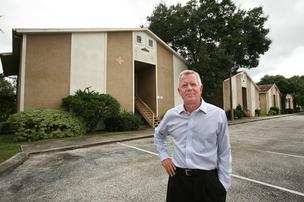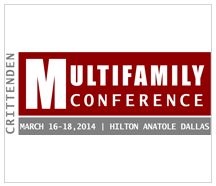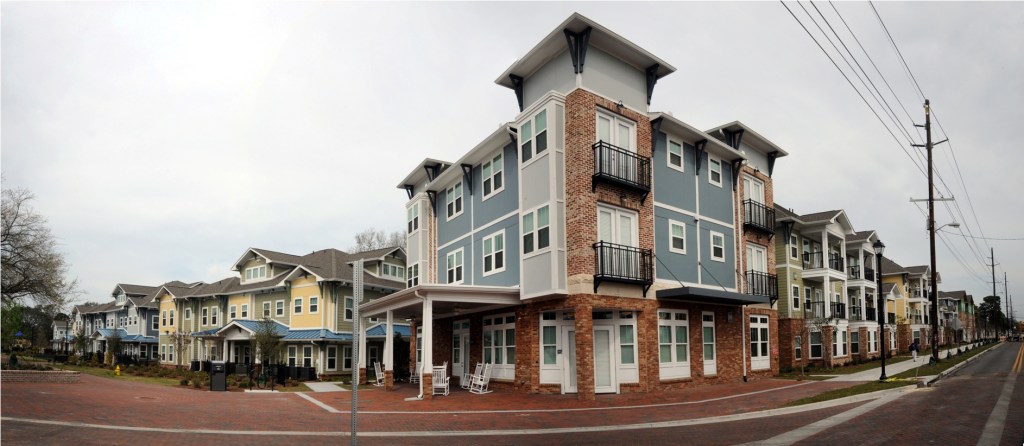The apartment industry has played a major part in the revitalization of the real estate sector while also significantly contributing to the American economy. Rental market activity has grown at a moderate yet constant pace in most metros around the country, with up to seven million new renter households forming the last decade—almost half of all new households, according to data from the National Apartment Association (NAA) and the National Multi Housing Council (NMHC). The post-recession slowdown in construction has translated into a tight housing market with low inventory levels and climbing rental rates. Corroborated with the massive influx of new renters entering the market, the multi-family sector is poised for more growth in 2014. It would take approximately 300,000 to 400,000 new apartments each year to meet current demand, yet just 158,000 apartments were delivered in 2012. Tech-savvy young professionals generally identified as members of the Gen Y cohort have long been considered the most influential renter demographic for the apartment sector. However, a new type of renter has recently showed up on the real estate radar, which may well reshape the residential market in the coming years. Several industry leaders seem to think that baby boomers could become a key renter demographic in the coming years as empty nesters move out of the houses where they raised families and downsize into cozier, more sustainable apartment units. A Research Notes recently published by the National Multi Housing Council aims to provide some perspective on the issue by analyzing the effect of two key demographic trends: the increasing population and the changing age distribution of that population. NMHC reviews several aspects impacting the nation’s housing choices including demographic, economic and lifestyle trends. Demographics influencing demand. A simple look at census data shows the population...
Managing Turnover
Anticipation is vital
For most property management companies, how well resident turnover is managed is a huge part of the profit picture. There’s no more critical component in managing turnover than simply and effectively anticipating those turns. Apartment buildings anticipate a 50 to 60 percent renewal rate, says Trudy von Keudell, property manager at Coast at Lakeshore East in Chicago. If 30 leases are up for renewal at the end of June, it’s not uncommon for 15 of those to renew and an equal number to not renew. Those 15 residents may be buying a home or being transferred by their employer, or leaving for some reason having nothing to do with the building. “So you have to anticipate resident turnover,” she says. “If you’re not, you’re not being realistic.” Anticipation is vital because best practices in managing turnover start before residents move out, says Shailene Casio-Smith, vice president of Austin, Tex.-based residential property management company FirstService Residential Realty. The property shouldn’t experience a mass exodus in one month or in the middle of its lowest leasing season. Ensuring it doesn’t “helps manage the property’s turn costs, so there’s not a spike in expenses, or a dip in NOI,” she says. “A lot of your lease optimizer software programs manage that for you.” Many property managers find it helps to do as much pre-planning as possible, so they’re ready to hit the ground running when a current resident departs. “We try to get the client to allow us to do a pre-departure inspection so we understand the full scope of work we have to do,” says Dylan Pichulik, CEO of New York City-based XL Real Property Management, which manages individual apartments in small buildings for absentee owners. “That way we can line up all the necessary equipment,...
Insights on Instagram...
For multi-family marketing
Buckingham Companies began this year with a slew of accolades, among them a Prodigy Award for Best Overall Marketing Program, another for Best Color Advertisement, and the Bronze Adrian Award for Complete Campaign and Posting. At the foundation of those achievements stands an innovative marketing department that enhances traditional marketing approaches with a tool that many competitors have kept at arm’s length: Instagram. Unlike Facebook and Twitter, Instagram is an entirely image-driven social media platform with more than 200 million users worldwide. While Facebook and Twitter usage has hit plateaus, Instagram is one of the fastest growing platforms with a notable international audience, and 65 percent of the community is from outside of the United States. It is the ideal tool for reaching local renters and transplants. Buckingham Companies’ team dove into Instagram as a major component of their marketing strategy for CityWay in downtown Indianapolis. MHN caught up with Marketing Manager Nicole Crosby to explore the method behind their success. MHN: Tell me about your Instagram strategy for CityWay and how it enhances your brand. Crosby: Traditional real estate marketing is often visualized through staged and perfectly edited photography, alongside a carefully crafted list of features and amenities. As marketers, of course we want to show our properties in the best light possible, but today’s customers expect more. They want to understand what it’s really like to live there, to spend every day there. Instagram offers a way for our residents and on site teams to capture the perspective of everyday living and connect with our property, in some cases before they even set foot in our leasing centers. Our prospective customers are craving that connection in their apartment search. Highlighting Instagram on our property websites provides a first step in that connection. MHN:...
Landscape Architecture
Investment Property Curb Appeal
Curb appeal is key when it comes to your investment properties, be it residential projects or commercial developments. Whether you want to attract or retain residents at your apartment community, or create a stimulating office environment, creating curb appeal may help you get ahead of the competition while delivering a top-quality product. Curb appeal may mean a lot of things, from the general appearance of the space and building architecture to cleanliness and landscaping. Multi-family experts agree that the first impression that the prospective client gets when entering a property may be decisive in the selection process; but it does not stop at that. By providing great recreational amenities, you’ll be making it increasingly difficult for existing residents to depart. Curb appeal can bring you up or take you down, depending on what you have to offer, hence the importance of adopting a holistic approach when embarking on development projects. Moreover, curb appeal may be used to give a huge boost to your marketing efforts. Make sure you feature photos spotlighting the curb appeal of your communities when running social media campaigns, online ads and any other promotional crusades. It can be effectively used to transmit a visual message by translating it into promotional language and integrating it into your marketing pitches. Descriptive lines such as “beautifully landscaped community”, “lush English-style gardens” or “modern design complementing existing architecture” will render your property unique and memorable, so as it sticks in your prospects’ minds. Visualization is a powerful tool when trying to turn the tables in your favor. Prospective customers may easily picture themselves lounging around at your community’s infinity pool, enjoying exquisite sunsets on the rooftop garden while sipping on a favorite cocktail, or barbecuing with friends. It’s these kinds of images that linger and make prospects want to buy what you’re selling. As one of Texas’ largest landscape architecture and planning firms, TBG has witnessed first-hand the effects of well-constructed environments. Heavily -sought after properties are most often defined by their ability to provide inclusive environments where functionality meets sustainability and innovative design. Just like location, price or staff responsiveness, curb appeal may act as a deal breaker in today’s competitive market. “There is a great focus on including outdoor spaces in commercial projects whether it be a small courtyard where people can interact, a rooftop garden or site landscaping”, Bill Odle, managing principal at TBG Partners’ Houston office, told the Houston Business Journal. “That is nothing new or earth shattering. What has changed is that owners and developers are bringing TBG in at the beginning of the project, and landscape spaces are not just an afterthought. It’s a priority and a way for them to distinguish themselves and their projects. Outdoor spaces are now becoming the reason someone chooses to buy which is very powerful.” Founded in 1987, TBG Partners has evolved from a small practice in Austin to a multifaceted firm with offices throughout Texas as well as in Florida, Oklahoma and Dubai. Their portfolio includes developments at all scales around the world, from mixed-use and residential communities to corporate campuses, civic buildings, hotels, resorts, healthcare and educational facilities, city parks, and historic sites. The company has several big projects on roll in Texas, including Toll Brothers’ Sienna Plantation, a 10,500-acre master-planned development in Missouri City which is expected to contain 7,200 homes by year’s end. TBG developed a comprehensive master plan and landscape architecture program for the community which included the integration of schools, churches and retail with Sienna’s 19 distinctive neighborhoods; pedestrian-oriented streetscapes for a plus of vibrancy; and an extensive trail network successfully connecting parks and lakes with the community’s retail and residential fabric. Boasting more than 2,000 acres of green spaces, parks, recreation areas, lakes, greenbelts as well as a golf course, Sienna Plantation is a success story and a remarkable example of a premier amenity-rich community. It is one of the...
Bruce Keene
Franklin Street
Residents are sometimes quick to post negative reviews on apartment rating sites, but don’t always take the time to write positive reviews. However, there is a solution to this. MHN talks to Bruce Keene, president of management services of Tampa, Fla.-based Franklin Street, a Yardi client, about some trends he is seeing in property management, such as how to get positive reviews on ratings sites. MHN: Tell me about Franklin Street. Keene: Franklin Street is a real estate services company. We provide a myriad of services not only to the apartment investor, but also to the retail sector. The company itself has four divisions: one of them is the property management division, which manages both multifamily and retail, one division is the investment/sales division, which is the brokerage division, there’s a capital advisors division, which finds debt and equity for investors, and we also have a property and casualty insurance company that provides that service to property investors. So it’s a one-stop shop for the real estate investor. Currently we manage about 4,000 apartment units and about 5 million square feet of retail. MHN: What are some multifamily property management trends that you’re seeing in Tampa? Keene: Since the economy has improved and the apartment market in general has improved, I think that everyone is more focused on fine-tuning the operations for maximum performance. We’re not fighting concessions anymore, we’re not fighting for rents anymore, and we’re not fighting occupancy issues anymore. Especially in our markets, concessions are gone, occupancies are up and it’s time to focus on customers and maximizing efficiency in the processes we use. There’s one trend in particular that’s interesting that I’ve been looking into and we’ve began to use, and that’s a focus on certain technologies that will improve...
Excellence Awards
For the multifamily industry
The MHN Excellence Awards recognize the multifamily industry’s most noteworthy people, companies and properties. The 2014 winners will be selected by a panel of judges representing expertise across all multifamily disciplines. Submissions will be due by Monday, July 7 (deadline has been extended). Here’s how to enter. 1) Select the categories you’d like to enter and click to download those entry forms for rules and instructions; • Executive of the Year • Property Manager of the Year • Leasing Agent of the Year • Development Company of the Year • Property Management Company of the Year • Best Brokerage Office • Transaction of the Year • Best Apartment Community • Most Tech-Savvy Community • Best Marketing Program • Best Value-Add Renovation • Best New Development and Design • Best New Development: Unbuilt 2) After completing the entry form(s), click here to upload form and submit payment online (You still have the option of mailing us your entry as hard copy in a binder and/or paying by check; follow those instructions after you download the entry form from the list above.) If you have questions, contact Diana Mosher, Editorial Director at [email protected] Finalists will be announced in August at www.multi-housingnews.com and winners will be announced in September at a special event in New York and published in the October issue of the magazine. All winners will receive a personalized award for display in their office or multifamily...
A Winning Combo
Mixing Residential and Retail
The nation’s home ownership rate is on the decline as rising real estate prices and mortgage rates hold back demand. According to the latest data from the U.S. Census Bureau, the ownership rate dropped to 64.8 percent in the first quarter 2014 from 65.0 percent in the first quarter 2013 and 65.2 in the previous quarter. The rate is the lowest since the second quarter of 1995, when it was 64.7 percent. The Census report also shows that approximately 86.2 percent of the housing units in the United States in the first quarter 2014 were occupied and 13.8 percent were vacant. Owner-occupied housing units made up 55.9 percent of total housing units, while renter-occupied units made up 30.3 percent of the inventory in the first quarter 2014. Renting has started gaining ground mainly due to a combination of factors, including slow job growth, staggering economy, tight mortgage credit and declining affordability. In the first quarter 2014, the median asking rent for vacant for rent units was $766, whereas the median asking sales price for vacant for sale units was $139,200. Aside from the financial considerations, a lot of people turn to renting because of the flexibility that it entails. It’s no secret that young professionals follow the job trail and seek housing that best accommodates their lifestyle needs. Often times, this means that proximity to employment cores, recreational and shopping destinations, as well as sustainability, walkability and comfort turn into powerful retention drivers. While the Millennial generation remains the key renter demographic, baby boomers are expected to give a huge boost to the rental market, particularly due to the increasing number of empty-nesters who are looking to downsize and move into more sustainable homes. With consumer attitudes and habits on an ever-shifting path, the real estate landscape is bound to change as well. For the contemporary renter, mixed-use developments – usually retail and residential units wrapped around each other so as to offer a cohesive live-work-play environment – have become the place to be. Yardi client The Bozzuto Group, a Greenbelt, MD-based real estate services company, builds on such principles as quality, diversity, and inclusion and strives to deliver enhanced communities to cater to today’s most discerning renters – and all of this while respecting the world in which we live. The company’s newest mixed-use development in Washington, D.C., combines a premier location on stately Wisconsin Avenue with brilliantly designed residences and state-of-the-art retail. Dubbed Cathedral Commons, the project is a joint venture of Ahold USA, parent company of Giant Food, Bozzuto Development Company, and Southside Investment Partners of Baltimore. The boutique style building offers 138 apartment residences and eight townhomes which will be available in fall 2014. Among a series of upscale amenities, the property will feature a hotel-style lobby; fitness center; a library and conference room for private meeting space; resident lounge for hosted community social functions; rooftop deck and private outdoor courtyards; and a 24-hour concierge offering Bozzuto’s Top Notch services. Interiors will showcase contemporary design elements, including a chef-inspired kitchen with quartz countertops, custom oak flat-panel cabinetry, white beveled subway backsplashes and upgraded stainless appliances. Living spaces will include hardwood flooring and contemporary chrome LED track lighting, while bathrooms will boast Florentine Carrera floors and showers, chrome fixtures, and custom-designed vanities with integrated square sinks. The retail component, scheduled to begin delivering this fall, includes Barcelona Restaurant & Wine Bar, Raku, iDoc Optical, Wells Fargo, SunTrust, CVS Pharmacy, and Starbucks, as well as the 56,000-square-foot Giant Food, which will bring a new urban prototype concept to the project. H&R Retail handles leasing at the property. “We are excited to bring a mix of locally-based retailers and national brands to one of the most established and historic neighborhoods in the District,” said Toby Bozzuto, president, The Bozzuto Group. “Cathedral Commons and its new retail center will be vibrant, modern additions to Wisconsin Avenue and Northwest D.C....
Melissa D. White
GFI Management Services
Melissa D. White is a Millennial specializing in multifamily marketing, which means she is perfectly poised to understand what renters of her generation want and need from their apartment leasing experience. And thanks to fast-paced technological innovation in the realm of real estate and the willingness of her employer, GFI Management Services, to try new things, she’s also able to deliver the desired experience. That’s not just a win-win, but a win-win-win, with prospects, apartment front office employees, and Melissa all reaping the benefits. “It’s given me the power of time. You’ve given me my time back to go out and manage my team,” said White, who has been working in the multifamily industry for a decade. She quickly climbed the corporate ladder to become GFI’s Director of Marketing and Training, a position that puts her right in the vortex of multifamily tech advancement. “I never expected that this much technology could be possible in multifamily – I think of it as a Leasing Virtual Assistant,” said White, whose teams use Yardi products for their day-to-day sales operations and marketing tasks, including managing ILS listings, lead tracking, and social media content distribution. Like most Millennials, White sees the myriad benefits of technology-aided workflows. Training, distributing listings, following-up on prospect interest, advertising specials and promotions, measuring ROI in content and media, and even the act of leasing have all become more streamlined, systematic and automated in the last year, she noted. “We look at Yardi as our partner. You’re not just a vendor, and we’re not just a client. You’re our partner in offering sustainable onsite solutions and valuable services to our residents,” said White. While GFI has adopted numerous Yardi products, among her favorites is RentCafe, a comprehensive marketing solution which allows for automated...
Pillars of the Industry...
NAHB Award Nominations
The National Association of Home Builders (NAHB) is now accepting applications for its annual Pillars of the Industry Awards competition, the most prestigious award of its kind. Since 1990, NAHB has issued Pillars of the Industry Awards to the most outstanding leaders and innovative thinkers in the multifamily industry. Now is your chance to be recognized for your contributions to the industry, from design and development to innovative financing strategies and management. Participants may submit their applications in five primary groups: Developer Award Categories Marketing Award Categories Individual Award Categories Development Firm Award Category Property Management Company Award Eligible applicants include multifamily owners and developers, architects, property managers, and other multifamily industry professionals. Applications are due on June 23, 2014. The application fee is $295 for NAHB Members and $395 for non-members. Forms must be submitted to nahb.org/pillarsawards. For more details, visit the aforementioned website of call NAHB’s Multifamily Council at 800-368-5242 extension 8130. NAHB has honored Yardi client Alliance Residential with several Pillars of the Industry awards for its exemplary multifamily properties. Last year, the fully integrated real estate operating company won the award for Best Mid-Rise Apartment for Icis, a collaboration with TCA Architects. The community’s uncommon amenities include a resort, three rooftop decks, a spacious outdoor amphitheater with the latest media and gaming technologies, a full service salon, and a luxury lounge. Units offer 9’-to 20’- foot ceilings, natural stone countertops, hardwood floors and tech goodies throughout such as Smart Box wiring, USB connections on outlets, and AV surround home theater system. Breathtaking views of The Hills and Los Angeles complete a truly unique living experience. Alliance Residential also received the award for Best Clubhouse at a Multifamily Community for Broadstone North Boca Village, a collaboration with MSA Architects. The 11,000-square-foot...
Crittenden Conference...
Multi-family tech insight
Achieving renter happiness might be tied to the same desires that have made fast food and Amazon Prime among the most popular innovations of our time. Are you offering your residents instant gratification? That was one of the technology trends discussed on a panel at the recent Crittenden Multifamily Conference in Dallas, Texas. Industry experts John Pendergast, senior vice president of client services at Yardi; Ray Thornton, senior vice president of information technology at MAA; and Tom Bumpass, managing director and chief information officer for Greystar Realty Partners, participated in the panel that focused on the past, present and future of multifamily technology. With advancements in the areas of cloud services, business intelligence, single stack solutions and mobility, there’s enhanced opportunity not only to improve resident’s experiences, but to foster a more collaborative working environment at the home office. With the move of most management platforms to a cloud-based environment, creating a true partnership between the IT department and the business and marketing specialists within your firm is an enhanced focus that can produce enhanced efficiency, processes and results. “It’s not enough for the IT group to be a support for the operations and marketing teams. In order for businesses to be successful today, there has to be a partnership between the technology group, business/operations group, and marketing group. That means all the groups are working together throughout the process of meeting your business needs. They’re a collective team,” said Pendergast (pictured, left). Delivering a successful business intelligence solution is one area in which such collaboration is especially important. When Greystar Realty Partners developed their internal BI solution, the business and IT sides of the firm worked hand-in-hand. Now, adding additional data points into the system is a much faster, less complicated process. “They’re...
Tawny Crazy Ants
Newest property pest
Just as the bed bugs craziness fades from the media, a new pest is working its way through the nation. Tawny crazy ants have caused more than $146.5 million in property damage in the state of Texas alone. And they’re spreading. Nylanderia fulva, simply called the crazy ant, is a tawny-colored, hairy critter that’s about 2mm long. Some males have wings (but the merciful Mother Nature has at least prevented them from flying). Unlike most ants that move with a calculated sense of purpose, crazy ants move erratically. They enjoy the warm, humid climates of the Gulf Coast and have been spotted on properties in Florida, Mississippi, Louisiana, and Texas. Crazy ants do not pose the traditional threats. Their bite may leave an itchy red spot but they don’t have a stinger and will rarely cause an allergic reaction. They do not swarm when their mound is interrupted because they don’t form mounds. That’s the beginning of the problem. Rather than building an easily visible mound, crazy ants love settling into nooks and crannies. They don’t stick to the rocks and trees outside. The like to enter crawl spaces, cabinetry, car engines, potted plants, pipes, and even hide out in electrical equipment—and therein begins the costly property damage. The crazy ants seek the cozy warmth of electrical boxes. Invariably, one of them will be electrocuted by a hot wire. Rather than just dying peacefully, the corpse releases pheromones that summon all of the ant’s family, friends and neighbors to come avenge its death. If the ant had been attacked by an enemy, the battle cry would be worthwhile, helping to protect the group and the queen. But since the enemy is a live wire, the carnage continues, which often causes short circuits and damage. In other cases, crazy ants can cause damage simply by their numbers. They congregate in groups so tight that they resemble dirt (left). The massive clustering of their little bodies can cause congestion in pipes or cause electrical components to overheat. In the long term, the presence of crazy ants can lead to ecological problems. If your property prided itself on the lovely birds and butterflies in your gardens, you may be seeing fewer of those flying beauties. Crazy ants can eliminate entire fire ant colonies—which is excellent according to popular opinion—but they also eradicate other arthropods and small insects like spiders, centipedes and caterpillars. Animals that feast on tiny insects will lose their food source and have to seek it elsewhere. Inconveniently, birds don’t eat crazy ants. Researchers at Sam Houston University are working to create an eradication plan but have yet to release a definitive solution. Using current methods, a pest control specialist can issue three or four treatments of Termidor SC or Phantom Termicide/Insecticide over several months to keep the critters under control. But crazy ants are resistant to most commercial treatments. And even if one community is destroyed, another will likely form. Colonies tend to have multiple queens, so they rebuild quickly. To minimize damage to your property, consider a few best practices: Stay on top of your landscaping After spring storms, promptly clear fallen leaves and limbs to minimizing crazy ants’ favorite outdoor hideouts. Improve drainage Crazy ants breed quickly in moist areas. Leaky exterior pipes should be fixes. It’s also a good idea to improve drainage throughout the property; if there are areas of the landscape that tend to pool, consider creating a rain garden that will control moisture. Minimize moisture inside the building Tawny Crazy ants enjoy tight spaces with moisture. Aim to keep basements and crawl spaces dry. In the humid southeast, it may be helpful to use dehumidifiers throughout the building. Remove food sources Crazy ants eat like any other ant. They are particularly drawn to sugary substances. Hummingbird feeders and birdbaths are like buffets to crazy ants. Find ant deterrent models or drain them, leaving...
Millennial Managers
Choice, not Chance
As Baby Boomers by the thousands prepare to retire, training their successors is taking on fresh urgency. Anecdotal evidence suggests that a growing number of people are making real estate management a career of choice rather than chance. Nevertheless, some experts contend that the profession must further step up both recruitment and mentoring. All too often, some leading executives contend, the industry is unwittingly discouraging its own talent pool by placing too much weight on experience. And while IREM, Building Owners and Managers Association International and other groups sponsor outreach programs and networking opportunities, Joe Greenblatt, IREM’s 2014 president and president of San Diego-based multi-family specialist Sunrise Management, finds that young people often feel frustrated about the lack of responsiveness from prospective employers—and that is a missed opportunity. Once they’ve been hired, managers of all ages say, employers would do well to cater to the very distinctive traits 20-something professionals tend to share. To begin with, Millennials prize mentoring. Communicating back and forth is a must, according to Dee Headley, an Indianapolis-based vice president for Cassidy Turley and chair of IREM’s advisory board on student and academic outreach. And the more specific the expectations, the better, notes Va’Shajn Parr, who joined La Jolla-based Capital Growth Properties Inc. as an assistant property manager last summer and works on two portfolios comprising 33 properties. Furthermore, feedback should be individually tailored, says Kacey Morris, director of property management for Prologis Inc. in metropolitan Atlanta. Another essential Millennial quality is zeal to take on challenges right out of the gate. After all, this energetic, hands-on generation wants to make important contributions, according to Kent Bell, a property manager for Washington Real Estate Investment Trust. Karen Whitt, COO of U.S. real estate management services for Colliers International, likes to...
Affordability Crisis
Hurting for housing
Every morning at 8am, the construction crews begin working on the neighborhood behind my home in an Atlanta suburb. The sounds of hammers, trucks, and lively music are a sign that the housing market is recovering. While these lots will make lovely homes for some, their $250,000+ price tags exclude buyers most in need of housing relief. The nationwide shortage of affordable housing is getting worse. There’s no housing shortage. Skylines receive new jewels every quarter as developers jump on the luxury high-rise trend. Even single-family builders are stretching their legs with post-recession vigor. Big spenders have an increasing number of options. Middle- and low-income families, however, are the ones scrambling to find shelter while making ends meet. There are two notable causes for the affordable housing shortage: the widening chasm between incomes and rents, and investors’ lack of interest in affordable housing. The gap between incomes and rents grows wider. Research conducted by the Joint Center for Housing Studies (JCHS) shows median incomes plummet by 13 percent between 2000 -2012. While incomes decreased, the population of extremely low-income renters doubled in less than a decade. Of renters making less than $15,000 per year, 24 percent reported hardships with lease payments. Rent—not transportation, electronics, or clothing—is continually absorbing a larger amount of American’s income. The lowest-income renters are scaling back on food, sacrificing about $100 each month to pay for housing. The JCHS study revealed that half of today’s renters spend more than 30 percent of their income on housing; one in four families spend more than 50 percent. A study by National Low Income Housing Coalition (NLIHC) places that percentage closer to 75 percent. Incomes shrink while rent rates are continuing to increase. From 2000-2012, median rents skyrocketed by 6 percent. Rising costs can’t dissuade renters. There aren’t many other options. The influx of post-recession renters to the market drives fierce competition, turning even the priciest, tiniest rentals into a battleground. In these cost wars, low-income renters have been left out of the negotiations. There simply aren’t enough affordable units to go around. NLIHC estimates that there are 10.1 million extremely low-income households and only 5.6 million housing units to accommodate them. Almost half of these household contain children and are at high-risk for homelessness if more housing is not created. But affordable housing has not been on the top of many agendas. In 2008, President George W. Bush initiated The National Housing Trust Fund. The fund would create, maintain, and renovate affordable rental housing communities. Though he gained support from both sides of the aisle, the trust never received funds. Affordable housing faces local setbacks as well. Some local governments and community groups refuse to approve affordable housing in their areas. Their concerns are rooted in antiquated views and stigmas surrounding affordable housing. Home Matters was created in 2013 to educate local powers about the new and improved face of affordable housing: eco-friendly, stylish neighborhoods that are rich with engaging community programs and increasingly self-sufficient tenants. Nearly 200 local and national organizations have joined forces under Home Matters. They hope to change public opinion about affordable housing and in turn increase support and funding for these vital...
Surviving the Drought
Water-saving tips for multifamily
Rain and snow in California have been so scarce over the last three years that about 95 percent of the state is in drought. Along environmental challenges, the ongoing drought has led to a stressed water system which menaces everything from local economies to agriculture and day-to-day living. And although there’s been a slight improvement with the heavy rains in Northern California this month, the state’s water supplies have dipped to alarming levels. The Sierra Nevada snowpack, which is the major source of water and a significant source of electric power generation in California, is approximately 20 percent of the normal average for this date, according to official statements. California’s major river systems, including the Sacramento and San Joaquin rivers, have significantly reduced surface water flows; and groundwater levels throughout the state have dropped significantly. Governor Jerry Brown Jr. urged all Californians last month to voluntarily reduce water usage by 20 percent. “We can’t make it rain, but we can be much better prepared for the terrible consequences that California’s drought now threatens, including dramatically less water for our farms and communities and increased fires in both urban and rural areas,” said Governor Brown. “I’ve declared this emergency and I’m calling all Californians to conserve water in every way possible.” Cloverdale and Healdsburg in Sonoma County, Willits in Mendocino County, the small Lompico Water District in the Santa Cruz Mountains as well as several other rural communities in the area may face severe water shortages in the next 60 to 100 days due to excessive drought conditions, according to the California Department of Public Health (CDPH). President Obama has recently travelled to drought-stricken California to offer support and pledged to provide approximately $183 million in drought relief funds; the money will go toward things such as livestock disaster assistance for producers, conservation and helping rural communities with vulnerable water systems. “California’s message to the President today is loud and clear: we need to work together and take immediate action to respond to this drought”, said Ann Notthoff, director of California advocacy for the Natural Resources Defense Council. “Californians overwhelming agree that investing in irrigation technologies, water conservation and recycling and local water resiliency are among the strategies that will reduce the effects of this drought and will also make California more drought resilient in the future.” “A federal climate resilience fund will help us meet those goals. State and local funding and planning will also be critical. We look forward to the President and Governor Brown working together to ensure we’re helping Californians get through the drought today while becoming better prepared for a drier future to come,” Notthoff added. While state and local officials continue to work on long-term solutions to water challenges around the country, it’s imperative that we all take an active stand on the matter. By promoting responsible water consumption among community residents, property managers can significantly contribute to stretching the nation’s water supplies. Water-saving efforts have done wonders for Southern Nevada for example, where practically all water used indoors, from home dishwashers to the toilets and bathtubs used by the 40 million tourists who reportedly visit Las Vegas each year, is treated and returned to Lake Mead, The New York Times reports. Since 2002 when the drought response plan was first developed, Southern Nevada has reduced its water demand from about 314 gallons per person per day to about 219 GPCD (gallons per capita per day) in 2012. There are tons of easy ways to conserve water both indoors and outdoors. The Save Our Water program, a partnership between the California Department of Water Resources and the Association of California Water Agencies, brings forth an array of tools and resources to help consumers reduce their water use, regardless of whether California is in a drought. Start with taking care of the outdoors. Outdoor landscaping, which plays a big role in enhancing a property’s curb...
Beacons
Always-On Connectivity
If your property was developed before 2000, it wasn’t built with cellphone and Wi-Fi reception in mind. The location, building materials, and sometimes the building’s design can hinder signals. Today’s renters won’t tolerate glacial-speed connectivity and inconsistent service. Beacons could help improve resident satisfaction, retention, and give you new ways to communicate with tenants. Beacons are the latest technology for any property that wants to improve cellphone reception and Wi-Fi availability. The small devices can be plugged into a wall or set on any surface. Their low-energy usage and low-cost makes them easy to add to any unit. Beacons use Bluetooth connection to send signals to devices such as smartphones and tablets, so there are no wires or tedious setup required. Basically, beacons can be used to amplify your wireless services. Offering them with your units could be a huge selling point for renters, particularly Millennial. There is a growing trend of Americans and Canadians who are ditching cable in exchange for Netflix, Hulu, and other streaming video services; some switch to save hundreds of dollars on their bills each year. Residents won’t be pleased if they feel coerced into a cable contract because they can’t stream shows at home. Tenants of all ages will appreciate faster speeds and more consistent service. It’s vital to their life’s work, in many cases. An increasing number of professionals work from home at least one day a week or more. Even those who aren’t remote employees are expected to have always-on connectivity, staying on top of their game by working evenings and weekends. If the internet is down or slow, their work will suffer and they’re likely to look elsewhere when it’s time to renew the lease. Owners may also toy with the idea of using beacons...
Market Report
Insight from Pierce-Eislen
The following article is excerpted from an article by Keith Loria in the January issue of Multi-Housing News. Find the the full story at Market Report: Ones to Watch. Pierce-Eislen is a subsidiary of Yardi Systems. Ron Brock, vice president and general manager of Pierce-Eislen, located in Scottsdale, Ariz., says that his Top 10 list of markets to watch in the upcoming year is projected to have a combined 6 percent rent growth in the next 12 months. He also believes his list is going to surprise some people, because some markets that were doing well this year are not going do very well next year. “If you look at the Bay area of Northern California, it’s all very good. You have the East Bay market, the San Francisco Peninsula and the South Bay/Silicon Valley market,” he says. “There are good jobs there. Like everything else, a composition of jobs brings some good income.” Austin, Texas is also on his list, and while Brock admits that it does seem to be overbuilding right now, the jobs being created are very attractive and pay handsomely, boding well for its future. “Other markets to say “yes” to in 2014 are West Palm Beach, Boca Raton, suburban Atlanta, which is a surprise, Miami, Denver, Orange County and the Southwest Florida Coast,” Brock says. “West Palm Beach is interesting because job growth isn’t so much a factor, but it’s the empty nester crowd. Retirees go there and are willing to pay. Same thing with the Southwest Florida Coast—people are showing up with money.” The Miami office space market meanwhile is being driven by money from outside the country, most notably South America. Suburban Atlanta is seeing an increase in job creation, which is the complete opposite of what’s...
End of Debt Forgiveness...
Will rental markets reel?
Just when we thought the housing market was stabilizing, the Mortgage Foreclosure Debt Forgiveness Act ended. To date, the act has not been extended, which could lead to a few notable changes in both the single-family and multi-family markets. Before 2007, a mortgage owner could receive a break on their loan as long as that forgiven debt was taxed. When the Mortgage Foreclosure Debt Forgiveness Act passed that year, it eliminated the tax on forgiven debt, allowing more cash to stay within the household. Homeowners were able to get back on their feet and into a rental—or even another house–more quickly. In January 2014, the Mortgage Foreclosure Debt Forgiveness Act came to an end. According to the National Association of Realtors, reinstating tax on forgiven debts may affect many of nearly 10 million Americans with underwater properties; currently, 14.5 percent of homes in the US are still in negative equity, reports the National Association of Attorneys General. Homeowners with underwater properties will be dissuaded from short sales and other measures of foreclosure prevention since they often don’t have the means to pay the difference between the mortgage cost and the home’s current value. They likely unable to pay high taxes on forgiven debts, either. Homeowners may still qualify for an insolvency exclusion but it’s a tedious route The result: more foreclosures. RealtyTrac reports that more than 1.2 million properties throughout the nation are in some stage of foreclosure. States such as Delaware, Maryland, and Connecticut were inundated with distressed properties during the recession and they will continue to see high numbers of bank repossessions. With fewer assistance programs in place, these homeowners will continue to enter the rental market in numbers higher than previously expected. The continued flow of tenants may keep vacancy rates...
Improved Payments, Process...
For Moss & Co. using Yardi
Moss & Company has improved resident screening, energy billing and management, and resident services at its multifamily rental properties with products from the Yardi Multifamily Suite™ that are integrated with the entire Yardi Voyager® leasing cycle. Moss & Company adopted Yardi Resident Screening™, an online resident screening system, to replace a paper-based screening system. “We place resident information into Voyager more efficiently, as we no longer have a third party involved in the screening or paperwork floating around. Resident Screening gives us confidence that we’re maintaining confidential information, and the quick return of information on prospects saves us the extra step of reentering the information in Voyager,” said Henriette Saffron, vice president and chief financial officer for Moss & Company. Yardi Payment Processing™ sharply reduced the time Moss & Company spent processing rent payments by converting paper checks into electronic payments in Yardi Voyager. “Payment Processing has saved us a tremendous amount of work,” Saffron said. “We process up to 12,000 resident rent checks each month, and the old-fashioned way of endorsing them and taking them to the bank and making copies has been eliminated. The funds download to the bank immediately and are available the next day. Our residents are very receptive to this payment method and it’s a huge selling point with potential clients whose properties we want to manage. There’s also instantaneous, automatic posting to the resident ledger, saving time as well as eliminating human error from incorrect input. It’s an amazing advantage for us.” Moss & Company has gained additional improvements in revenue collection and process efficiency since rolling out Yardi Energy Solutions™, an automated utility billing and energy management solution, in 2013. Yardi Energy Solutions includes submetering and ratio utility billing systems, vacant cost recovery, cost and consumption analytics,...
Apartment Marketing
Content, advertising, and more
The digital environment gives you the power to transcend physical boundaries and reach your audience wherever they are. Virginia Love, Vice President of Leasing and Marketing for Chicago-based Waterton Residential, thinks that a good online reputation is crucial in today’s marketplace. The company partnered with survey company SatisFacts and their Verified Resident Program to strengthen and promote their brand image. The project utilizes the largest apartment rating site to do additional surveying and direct those answers to additional questions back to the rating site and improve ratings and review scores. “For instance, it’s not about asking whether your dishwasher was fixed. There are additional questions in the survey after you get your dishwasher fixed, and those are the answers that affect your score on ApartmentRatings.com. Since it says that it is from a “Verified Resident,” there is a sense of gravitas. This is not some guy who drove by the property one time and didn’t like what he saw. It’s not someone who lived at a property 20 years ago when it was different management”, explained Virginia Love in an interview for the National Apartment Association. “That has allowed our associates to tell prospective residents, “These are people who actually live here. These are the ones you want to hear from.” When reviewing your advertising options and devising marketing strategies, one thing you should always consider is the type of audience that your product is addressed to and the tools you have at your disposal to monitor their engagement. When it comes to multifamily marketing, content should be personalized and relevant to prospective clients. For example, things that might entice residents of suburban communities might not seem appealing to those interested in urban lifestyles or high-rise living; you have to find the right balance...
Mills Properties
Developing mixed use in St. Louis
St. Louis isn’t known as a hipster haven. But the city’s developers are gradually embracing the concept of walkable urban neighborhoods. The reinvention of a portion of the city’s downtown, into what’s now known as the MX District, leads the way. MX stands for Mercantile Exchange, hearkening back to the days when downtown St. Louis was a commercial center. Yardi client Mills Properties was one of the first new developments to open its doors in the MX District when The Laurel apartments began leasing and welcoming residents in fall 2011. The Laurel, a mixed-use property with food and shopping on the ground floor, has attracted young professionals working in the biotechnology and medical fields, as well as students attending nearby colleges and universities. A popular local pizza joint, deli, wine bar and a restaurant serving Asian fusion cuisine are a major draw for residents, who enjoy a 10 percent discount on all purchases. The company has a second mixed-use project in progress that will feature a Whole Foods gourmet grocery on the ground level, and 177 apartments above. City Walk on Euclid will be located in the Central West End, and the Whole Foods will be St. Louis’ third such store. The Central West End has been a popular residential neighborhood since the 1904 World’s Fair, and City Walk residents will enjoy walkable access to a variety of restaurants and other amenities on Euclid. Mills Properties marketing manager Melissa DeCicco anticipates that the market’s widespread popularity will make walk-up leasing of the City Walk apartments as convenient as popping into Whole Foods for an easy deli-counter dinner. “I think we’ll have quite a few people right at the start of lease up who will want to be there because of the location, and Whole...
Trends to Watch
Storylines from ’13 that aren’t over yet
2013 was quite a year in the world of real estate. Whether your firm was moving forward with new technologies, revamping business practices to be more efficient, or raising rents and acquiring new properties, there was much forward momentum and positive change. Of course, it was only the first step for some of these long term evolutionary projects. Here are a few of the technology trends that will continue to advance widespread real estate industry change in 2014. Some outcomes are obvious, while others – well, we’ll just have to wait and see. Tablets, meet leasing agents – and executives. In 2013 tablets as leasing tools – whether for commercial or multifamily properties – became not just a much-coveted technology but a reality. Companies who armed their leasing agents with Yardi Leasing Pad reported that the agents loved the convenience of having wireless property data and collateral in one convenient, easy to use device. For the multifamily market, the integration with WhiteFence proved valuable as it was easy to compare utility options from all providers, also using a tablet. For executives, tablets are proving the most efficient way to access business analytics and intelligence while they are on the go. The browser-agnostic, mobile-enabled Yardi Voyager® 7S makes that easier than ever. Drones take to the sky – with cameras on board. This year we heard about drones delivering packages, spying on people, and becoming useful in real estate – as mobile property photographers. Equipping a drone with a camera for aerial property photography is much less expensive than sending a human photographer up in a plane – and for now, doesn’t impinge on airspace rules. Rest assured that we haven’t heard the end of any of the drone debates yet. Modular construction for the urban infill projects. This is a cool concept that we came across while reporting for Commercial Property Executive. In New York City, Forest City Ratner Companies is developing a major project at Atlantic Yards, with of 6,400 residential units spread over 15 buildings. Fully fabricated units, supported by a steel brace frame, will be stacked on top of each other to create an apartment community. If successful, the project could drastically alter the way new urban housing is designed and constructed. Micro-units make studios seem spacious. Micro-units first came on the scene in 2012, but in 2013 they were ready for completion and occupancy, which means that people are actually cramming their lives into their small footprints as we speak – and working out the kinks. Ron Brock, who observes nationwide real estate trends for Pierce-Eislen, observed in an interview that the jury is still out on these units – and whether residents will love them, or if walls need to be knocked down to make them more spacious. Presenting a single stack solution. As the apartment market returns to post-recession levels, savvy companies are capitalizing on improved business technologies that help them market to prospects, screen future residents, and collect hard data on residents’ payment and retention patterns. They’re finding that they can get all the programs they need from a single source, which makes workflows faster and easier and cuts down integration hassles. Single stack technology solutions are integral to building thorough databases, better serving customers, and producing dynamic business intelligence, and only a few companies that have developed comprehensive product suites to serve property managers. You’ll be hearing more about Yardi’s single stack in...
Learning to Like LEDs...
Bulbs gain multifamily traction
Multifamily professionals are torn when it comes to LEDs. While many love the idea of a bulb that lowers utility bills without sacrificing brightness, they aren’t in love with the high upfront costs. It can also be hard to tell when it’s worthwhile to invest in LEDs when halogen, fluorescent, CFL, or even incandescent bulbs might suffice. A few tips might make the decision easier. When it comes to longevity, LEDs are hard to beat. LED lamps can last up to 50,000 hours, outliving the average incandescent bulb by more than 10 times. This makes them ideal for hard to reach places like stairwells, parking lot posts, and ceiling-mounted security fixtures. LEDs are also incredibly useful for fixtures that must stay lit day and night. The light emitting diodes also have less practical and more fashionable applications. LEDs are now more versatile than ever, making them ideal for eye-catching applications in hip, newly constructed buildings. Different colors and warmths allow lighting designers to explore endless interior and exterior possibilities. Like their incandescent cousins, LEDs can now be dimmed, a feature that designers have craved for years. There is even a new line of OLEDs with thin, flexible lamps that promise innovative new creations like poster-thin televisions for fitness centers and bedroom windows that turn into lamps at night. Though the advantages of LEDS are evident, you must first make sure that you can provide the proper housing for the bulbs to reap their full potential. The longevity of LEDs helps the lamps to pay for themselves in just 4-6 years but such returns aren’t a sure thing. James Youngston, IALD, LC Principal at Gabler-Youngston explains, “Retrofit lamps are rated for 50,000 hours but that’s based on turning them on is sockets by themselves, not...
Data Driven
Ron Brock, Pierce-Eislen
When Ron Brock began forming the business idea that would ultimately become Pierce-Eislen, a data research firm focused on the commercial apartment industry, online databases and the Internet were still in the incubation stages. Fast forward a couple of decades, and Brock’s company, Pierce-Eislen (acquired in 2013 by Yardi Systems) is the leading provider of performance information about apartment communities. Nationwide intelligence on markets, developments, rents, occupancy and more can all be gleaned from the company’s reports. They are sought out by lenders, investors, developers, multifamily managers and economists as accurate indicators of economic trend and performance. With more than four decades now in the apartment industry, working as a developer, broker and business leader, Brock has tremendous perspective on how much the industry has changed. And as he observed in a recent interview, the rate of that change seems to be speeding up lately. “It wasn’t very long ago that the real estate industry was extremely unsophisticated. Even when we formed Pierce-Eislen, it was that way. You get the Millennials coming along, and they expect to be able to pull up some data on the Internet and do their work,” Brock said. Advancement in the warehousing and analysis of business intelligence, he said, has been beneficial to Pierce-Eislen as the company strives to provide bigger and better reports. “Until recently, we provided what has happened and what’s happening currently. We didn’t look forward. Now, we have a new system that has a forward look that we’ll be introducing sometime in the not too distant future.” Nationwide market intelligence Pierce-Eislen’s rent surveys target 60 major apartment markets around the country. A full market survey, comprising all properties in the given market of 50 units or more, is conducted three times a year. A smaller...
Steven Maher
Kinzie Real Estate Group
Condo conversions can be risky business. That’s the lesson learned in Chicago over the last four years, where many efforts to transition apartment properties into for-sale condominium units flopped – and in some cases even reverted back to apartments once again. Chicago, the nation’s third largest condo market, saw median sales prices plummet when the economy crashed. The Case-Shiller Home Price Index reports that the Chicago condo index is now back to July 2002 levels, having fallen a total of 22.5% from its peak in September 2007. Steven Maher, Managing Broker and Director of Investment Sales for Kinzie Real Estate Group, has had a close-up look at the Windy City’s winners and losers in sales and leasing for more than two decades. He specializes in urban infill development, particularly in the construction and adaptive reuse of mid and high rise condominiums, multi-family housing, resort properties, and condo conversions. After taking a close look at trends in Chicago adaptive reuse development, Maher shared his expertise with us. MHN: Condos, especially in urban markets, were one of the development types that really suffered when the economy spiraled. Many of them found new homes as apartment communities, rather than the owner-occupied use originally intended. Where was this type of reuse most common and was it successful? Maher: We have seen “fractured Condominium” projects all over the City as well as in the suburbs find temporary shelter as apartments. In some cases, especially when less than 25% of the units were sold, the properties were actually de-converted from condo ownership back to a single PIN and will likely remain as rental apartment buildings for the foreseeable future. In my opinion, this strategy has been most successful with condominium conversions that really should not have been converted in the...
Vine and Instagram
Multi-family tips and techniques
Apps can be great tools to connect with clients and potential customers. Get the most out of popular apps Instagram and Vine with tips that make your media stand apart from the crowd. Instagram Composition still matters While you don’t need to invest hours and money into taking professional photography classes, reading a few articles and YouTube tutorials on introductory photography techniques will definitely help. Choose your subject wisely While new appliances at a property are a good selling point for a property, a picture of a shiny oven won’t gain much interest. Rather, shows the subject in a broader context. Consider a resident–on trend, well-dressed resident– entertaining for their equally hip friends in the kitchen with new appliances. Accessorize your phone Nope, this doesn’t mean a bedazzled case. Rather, seek out camera enhancing accessories that will improve the quality of your photos. Most of these accessories cost far less than buying a point and shoot or DSLR camera. Try out Photojojo Lenses (below) for better zoom control and Flip Cage to stay steady, for starters. Skip panoramas It might seem like using your iPhone’s panorama feature is a great way to capture the beauty of a property or event but remember that Instagram photos are cropped to 612px X 612px squares. When taking your photos, think of squares rather than rectangles. If you must take a panorama, seek out another app such as Pic Stitch. Combine apps Although Instagram has filters, different apps offer a wider array of possibilities. You can edit your photo in an additional app, like Snapseed, and post it to the social media platform of your choice. Hashtag it wisely Too many hashtags can be annoying. No hashtags, however, mean that your image is basically lost in space, undiscoverable. Hashtags...






















